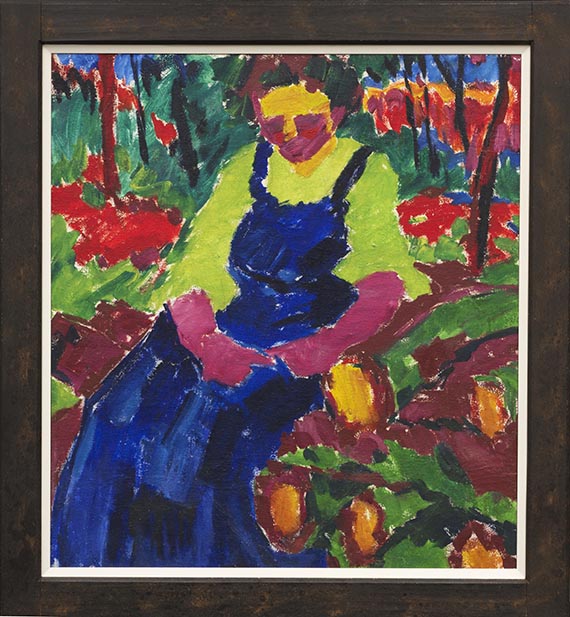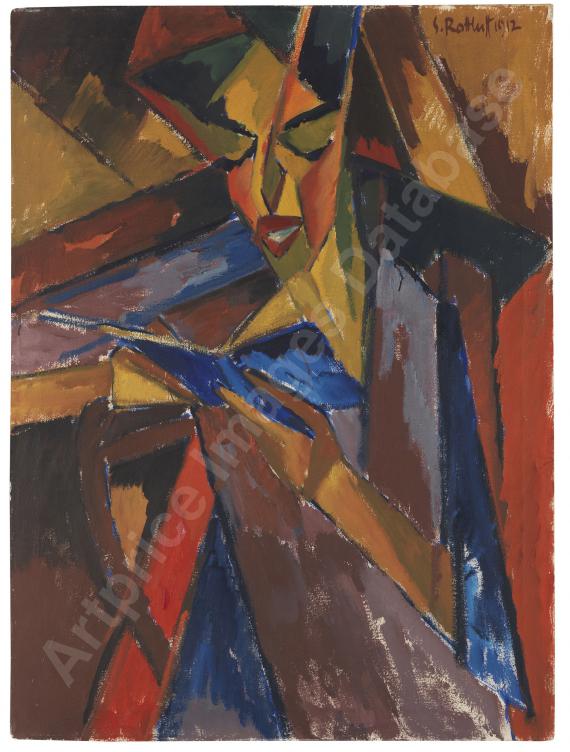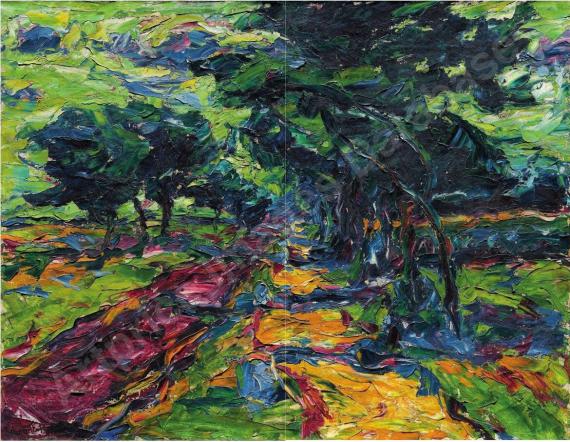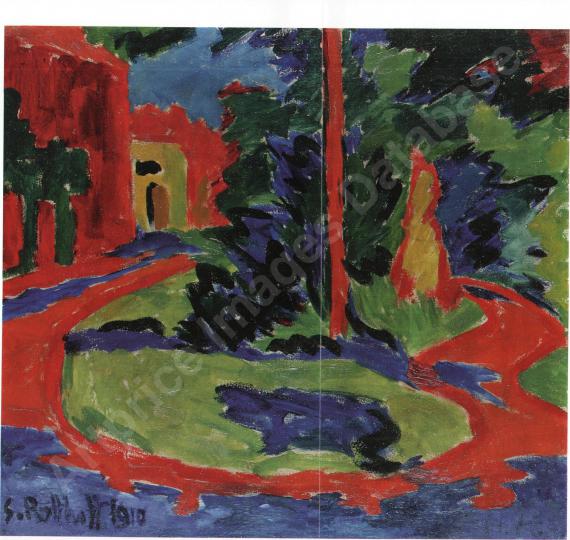122000108
Karl Schmidt-Rottluff
Sitzende im Grünen, 1910.
Olio su tela
Stima: € 400,000 / $ 428,000
Le informationi sulla commissione, le tasse e il diritto di seguito saranno disponibili quattro settimane prima dell´asta.
Sitzende im Grünen. 1910.
Oil on canvas.
84.5 x 76.5 cm (33.2 x 30.1 in).
[KT].
• During his summer stays in Dangast (1907-1912), Schmidt-Rottluff created the most seminal works of German Expressionism.
• In this work, Schmidt-Rottluff invented his extremely modern concept of nature with exuberant colors.
• Owing to the bold contrasts of the palette, this painting is a prime example of the ingenious "Brücke" style in 1910.
• Significant provenance: formerly part of the collection of Viktor and Hedda Peters, patrons and friends of the "Brücke" artists, Schmidt-Rottluff in particular.
• Of museum-quality.
The work is documented in the archive of the Karl and Emy Schmidt-Rottluff Foundation, Berlin.
PROVENANCE: Collection Dr. Viktor and Hedda Peters, Leipzig.
Hermann Gerlinger Collection, Würzburg (with the collector's stamp Lugt 6032).
EXHIBITION: Karl Schmidt-Rottluff zum 100. Geburtstag, Schleswig-Holsteinisches Landesmuseum, Schloss Gottorf, Schleswig, June 3 - August 12, 1984, cat. no. 8 (with illu.).
Karl Schmidt-Rottluff, Retrospective, Kunsthalle Bremen, June 16 - September 10, 1989; Städtische Galerie im Lenbachhaus, Munich, Septmeber 27 - December 3, 1989, cat. no. 64 (with black-and-white illu., plate 22).
Schleswig-Holsteinisches Landesmuseum, Schloss Gottorf, Schleswig (permanent loan from the Collection Hermann Gerlinger, 1995-2001).
Frauen in Kunst und Leben der "Brücke", Schleswig-Holsteinisches Landesmuseum, Schloss Gottorf, Schleswig, September 10 - November 5, 2000, cat. no. 15 (with illu. on p. 106).
Frauen in Kunst und Leben der "Brücke", Schleswig-Holsteinisches Landesmusuem, Schloss Gottorf, Schleswig, cat. no. 15 (with illu.).
Die Brücke in Dresden. 1905-1911, Dresdner Schloss, Staatliche Kunstsammlungen Dresden, Galerie Neue Meister, October 20, 2001 - January 6, 2002, cat. no. 323 (with illui.).
Kunstmuseum Moritzburg, Halle an der Saale (permanent loan from the Collection Hermann Gerlinger, 2001-2017).
Das andere Ich. Porträts 1900-1950, Staatliche Galerie Moritzburg, Landeskunstmuseum Sachsen-Anhalt, Halle (Saale), April 6 - June 15, 2003, p. 168, no. 257 (no illu.).
Die Brücke und die Moderne, 1904-1914, Bucerius Kunst Forum, Hamburg, Ocotber 17, 2004 - January 23, 2005, cat. no. 130 (with illu.).
Expressiv! Die Künstler der Brücke. Die Sammlung Hermann Gerlinger, Albertina Vienna, June 1 - August 26, 2007, cat. no. 17 (with illu.).
Buchheim Museum, Bernried (permanent loan from the Collection Hermann Gerlinger, 2017-2022).
Brückenschlag: Gerlinger–Buchheim!, Buchheim Museum, Bernried, October 28, 2017 - February 25, 2018, pp. 238f. (with illu.).
Schmidt-Rottluff. Form, Farbe, Ausdruck!, Buchheim Museum, Bernried, September 29, 2018 - February 3, 2019, pp. 154f. (with illu.).
Brücke und Blauer Reiter, Von der Heydt-Museum, Wuppertal, November 21, 2021 - February 27, 2022; Kunstsammlungen Chemnitz, March 27 - June 26, 2022; Buchheim Museum, Bernried, July 16 - November 13, 2022, p. 129 (with illu.).
LITERATURE: Hermann Gerlinger, Festschrift zum 95. Geburtstag von Karl Schmidt-Rottluff, Würzburg 1979, no p. (with illu.).
Gerhard Wietek, Schmidt-Rottluff. Oldenburger Jahre 1907-1912, Mainz 1995, p. 388, no. 127 (with illu.).
Heinz Spielmann (ed.), Die Maler der Brücke. Sammlung Hermann Gerlinger, Stuttgart 1995, p. 221, SHG no. 292 (with illu.).
Hermann Gerlinger, Katja Schneider (eds.), Die Maler der Brücke. Inventory catalog Collection Hermann Gerlinger, Halle (Saale) 2005, pp. 48f., SHG no. 70 (with full-page illu. on p. 48).
Hermann Gerlinger, Katja Schneider (eds.), Gemeinsames Ziel und eigene Wege. Die "Brücke" und ihr Nachwirken, Munich 2009, p. 45, illu. 24.
"The colors up here are incredibly strong, [..] almost sharp to the eye. Yet the color chords are of great simplicity. The only thing painting here can mean: relinquishing before nature at the right place is perhaps a definition of art."
Karl Schmidt-Rottluff 1909 in a letter from Dangast to Gustav Schiefler.
"Schmidt-Rottluff no longer imitates nature, he recreates it."
Magdalena M. Moeller
Oil on canvas.
84.5 x 76.5 cm (33.2 x 30.1 in).
[KT].
• During his summer stays in Dangast (1907-1912), Schmidt-Rottluff created the most seminal works of German Expressionism.
• In this work, Schmidt-Rottluff invented his extremely modern concept of nature with exuberant colors.
• Owing to the bold contrasts of the palette, this painting is a prime example of the ingenious "Brücke" style in 1910.
• Significant provenance: formerly part of the collection of Viktor and Hedda Peters, patrons and friends of the "Brücke" artists, Schmidt-Rottluff in particular.
• Of museum-quality.
The work is documented in the archive of the Karl and Emy Schmidt-Rottluff Foundation, Berlin.
PROVENANCE: Collection Dr. Viktor and Hedda Peters, Leipzig.
Hermann Gerlinger Collection, Würzburg (with the collector's stamp Lugt 6032).
EXHIBITION: Karl Schmidt-Rottluff zum 100. Geburtstag, Schleswig-Holsteinisches Landesmuseum, Schloss Gottorf, Schleswig, June 3 - August 12, 1984, cat. no. 8 (with illu.).
Karl Schmidt-Rottluff, Retrospective, Kunsthalle Bremen, June 16 - September 10, 1989; Städtische Galerie im Lenbachhaus, Munich, Septmeber 27 - December 3, 1989, cat. no. 64 (with black-and-white illu., plate 22).
Schleswig-Holsteinisches Landesmuseum, Schloss Gottorf, Schleswig (permanent loan from the Collection Hermann Gerlinger, 1995-2001).
Frauen in Kunst und Leben der "Brücke", Schleswig-Holsteinisches Landesmuseum, Schloss Gottorf, Schleswig, September 10 - November 5, 2000, cat. no. 15 (with illu. on p. 106).
Frauen in Kunst und Leben der "Brücke", Schleswig-Holsteinisches Landesmusuem, Schloss Gottorf, Schleswig, cat. no. 15 (with illu.).
Die Brücke in Dresden. 1905-1911, Dresdner Schloss, Staatliche Kunstsammlungen Dresden, Galerie Neue Meister, October 20, 2001 - January 6, 2002, cat. no. 323 (with illui.).
Kunstmuseum Moritzburg, Halle an der Saale (permanent loan from the Collection Hermann Gerlinger, 2001-2017).
Das andere Ich. Porträts 1900-1950, Staatliche Galerie Moritzburg, Landeskunstmuseum Sachsen-Anhalt, Halle (Saale), April 6 - June 15, 2003, p. 168, no. 257 (no illu.).
Die Brücke und die Moderne, 1904-1914, Bucerius Kunst Forum, Hamburg, Ocotber 17, 2004 - January 23, 2005, cat. no. 130 (with illu.).
Expressiv! Die Künstler der Brücke. Die Sammlung Hermann Gerlinger, Albertina Vienna, June 1 - August 26, 2007, cat. no. 17 (with illu.).
Buchheim Museum, Bernried (permanent loan from the Collection Hermann Gerlinger, 2017-2022).
Brückenschlag: Gerlinger–Buchheim!, Buchheim Museum, Bernried, October 28, 2017 - February 25, 2018, pp. 238f. (with illu.).
Schmidt-Rottluff. Form, Farbe, Ausdruck!, Buchheim Museum, Bernried, September 29, 2018 - February 3, 2019, pp. 154f. (with illu.).
Brücke und Blauer Reiter, Von der Heydt-Museum, Wuppertal, November 21, 2021 - February 27, 2022; Kunstsammlungen Chemnitz, March 27 - June 26, 2022; Buchheim Museum, Bernried, July 16 - November 13, 2022, p. 129 (with illu.).
LITERATURE: Hermann Gerlinger, Festschrift zum 95. Geburtstag von Karl Schmidt-Rottluff, Würzburg 1979, no p. (with illu.).
Gerhard Wietek, Schmidt-Rottluff. Oldenburger Jahre 1907-1912, Mainz 1995, p. 388, no. 127 (with illu.).
Heinz Spielmann (ed.), Die Maler der Brücke. Sammlung Hermann Gerlinger, Stuttgart 1995, p. 221, SHG no. 292 (with illu.).
Hermann Gerlinger, Katja Schneider (eds.), Die Maler der Brücke. Inventory catalog Collection Hermann Gerlinger, Halle (Saale) 2005, pp. 48f., SHG no. 70 (with full-page illu. on p. 48).
Hermann Gerlinger, Katja Schneider (eds.), Gemeinsames Ziel und eigene Wege. Die "Brücke" und ihr Nachwirken, Munich 2009, p. 45, illu. 24.
"The colors up here are incredibly strong, [..] almost sharp to the eye. Yet the color chords are of great simplicity. The only thing painting here can mean: relinquishing before nature at the right place is perhaps a definition of art."
Karl Schmidt-Rottluff 1909 in a letter from Dangast to Gustav Schiefler.
"Schmidt-Rottluff no longer imitates nature, he recreates it."
Magdalena M. Moeller
"Sitzende im Grünen" has an illustrious provenance. Shortly after it was painted in Dangast in the summer of 1910, Dr. Viktor and Hedda Peters acquired this painting. The Leipzig collector couple was one of the earliest patrons of the "Brücke" artists, especially of Karl Schmidt-Rottluff, with whom they were in a long and deep friendship. The work shows Gertrud Schmidt, the painter's sister, and Heinz Spielmann assumes: She repeatedly visited her brother in the fishing village, and the artist had never depicted a figure in the landscape in a painting before. (Die Maler der Brücke. Die Sammlung Hermann Gerlinger, Halle 2007, cat. no. 70)
The artist’s endeavors in painting in Dangast in 1910 proved to be groundbreaking, both in terms of pictorial and compositional accomplishments. In the course of 1910, the tendency to simplify the motifs into surface zones framed by dark contours or the blank canvas, intensified. With a loose brushstroke, Schmidt-Rottluff sketched the landscape around his studio in a virtuoso manner with an eruptive color presence. "Einfahrt" and "Deichdurchbruch" are outstanding examples of this dynamically animated stylistic development. Watercolors from 1909 and from 1910 suggest what should become content of his paintings, too: the pursuit of simplification combined with a subjective, colorful interpretation of the landscape. "Schmidt-Rottluff no longer imitates nature, he recreates it" (quoted from Magdalena M. Moeller). Through a reduction to what is essential, the contraction of a narrow and wide perspective on one level and the juxtaposition of strong and boldly placed color contrasts, the intense, striking effect is also achieved in this painting "Sitzende im Grünen": a harmonious unity of man and nature with daring contrasts and a new color palette typical of the ingenious "Brücke" style of 1910 that was probably perceived as shocking in those days. "In 1910, he applied the accomplishments he had made in watercolor to his paintings," says Schmidt-Rottluff expert Magdalena M. Moeller, longtime director of the Brücke Museum in Berlin. "The oil paint was applied highly diluted. It was as if the artist was more like drawing with the brush instead of painting. The thin paint allowed for a quick and facile application. A large number of paintings were created in the new technique. In close succession, Schmidt-Rottluff produced one masterpiece after another, as he had attained great mastery in all means. The colors are radiant, luminous, the forms more clearly defined and yet vibrate with energy. The previous bands of lines had evolved into short gestural brushstrokes, often clustered as surface structures. Jagged contours sometimes delimit the surface elements. Schmidt-Rottluff's new gestural language reflects the emotion of the creative process and the inspiration of the moment. Just as it is the case in his watercolors, he deliberately left parts of the canvas blank." (Quoted from: M. M. Moeller, Karl Schmidt-Rottluff. Eine Monographie, Munich 2010, p. 30)
On his way from Impressionism to Expressionism, Schmidt-Rottluff attained a fascinating intermediate stage that Ernst Ludwig Kirchner later called a "monumental Impressionism" in his 1912 chronicle. But there is even more to that: "Sitzende im Grünen" is a prime example in which some of the color forms and color surfaces clash very hard, while the confidence in his style was so strong, that its effect and the monumental expressiveness will be preserved for future admirers. Schmidt-Rottluff reached a first creative peak before World War I. What began to show in the painting "Straße im Norden", made during a visit at Emil Nolde in 1906, becomes a certainty in the explosion of colors we find in this work. [MvL]
The artist’s endeavors in painting in Dangast in 1910 proved to be groundbreaking, both in terms of pictorial and compositional accomplishments. In the course of 1910, the tendency to simplify the motifs into surface zones framed by dark contours or the blank canvas, intensified. With a loose brushstroke, Schmidt-Rottluff sketched the landscape around his studio in a virtuoso manner with an eruptive color presence. "Einfahrt" and "Deichdurchbruch" are outstanding examples of this dynamically animated stylistic development. Watercolors from 1909 and from 1910 suggest what should become content of his paintings, too: the pursuit of simplification combined with a subjective, colorful interpretation of the landscape. "Schmidt-Rottluff no longer imitates nature, he recreates it" (quoted from Magdalena M. Moeller). Through a reduction to what is essential, the contraction of a narrow and wide perspective on one level and the juxtaposition of strong and boldly placed color contrasts, the intense, striking effect is also achieved in this painting "Sitzende im Grünen": a harmonious unity of man and nature with daring contrasts and a new color palette typical of the ingenious "Brücke" style of 1910 that was probably perceived as shocking in those days. "In 1910, he applied the accomplishments he had made in watercolor to his paintings," says Schmidt-Rottluff expert Magdalena M. Moeller, longtime director of the Brücke Museum in Berlin. "The oil paint was applied highly diluted. It was as if the artist was more like drawing with the brush instead of painting. The thin paint allowed for a quick and facile application. A large number of paintings were created in the new technique. In close succession, Schmidt-Rottluff produced one masterpiece after another, as he had attained great mastery in all means. The colors are radiant, luminous, the forms more clearly defined and yet vibrate with energy. The previous bands of lines had evolved into short gestural brushstrokes, often clustered as surface structures. Jagged contours sometimes delimit the surface elements. Schmidt-Rottluff's new gestural language reflects the emotion of the creative process and the inspiration of the moment. Just as it is the case in his watercolors, he deliberately left parts of the canvas blank." (Quoted from: M. M. Moeller, Karl Schmidt-Rottluff. Eine Monographie, Munich 2010, p. 30)
On his way from Impressionism to Expressionism, Schmidt-Rottluff attained a fascinating intermediate stage that Ernst Ludwig Kirchner later called a "monumental Impressionism" in his 1912 chronicle. But there is even more to that: "Sitzende im Grünen" is a prime example in which some of the color forms and color surfaces clash very hard, while the confidence in his style was so strong, that its effect and the monumental expressiveness will be preserved for future admirers. Schmidt-Rottluff reached a first creative peak before World War I. What began to show in the painting "Straße im Norden", made during a visit at Emil Nolde in 1906, becomes a certainty in the explosion of colors we find in this work. [MvL]
122000108
Karl Schmidt-Rottluff
Sitzende im Grünen, 1910.
Olio su tela
Stima: € 400,000 / $ 428,000
Le informationi sulla commissione, le tasse e il diritto di seguito saranno disponibili quattro settimane prima dell´asta.




 Lot 122000108
Lot 122000108 



